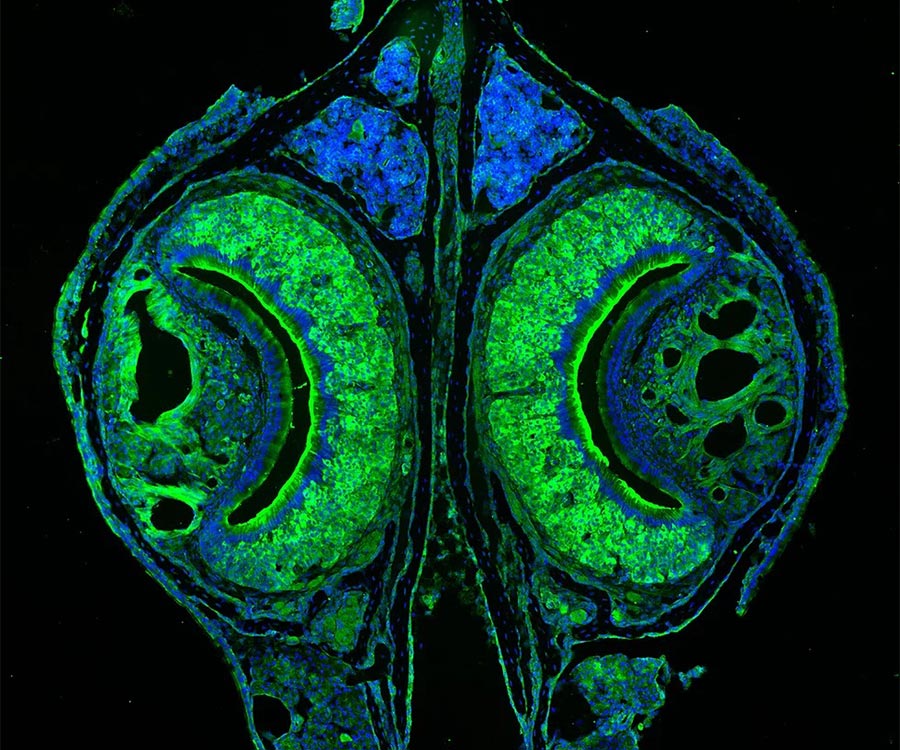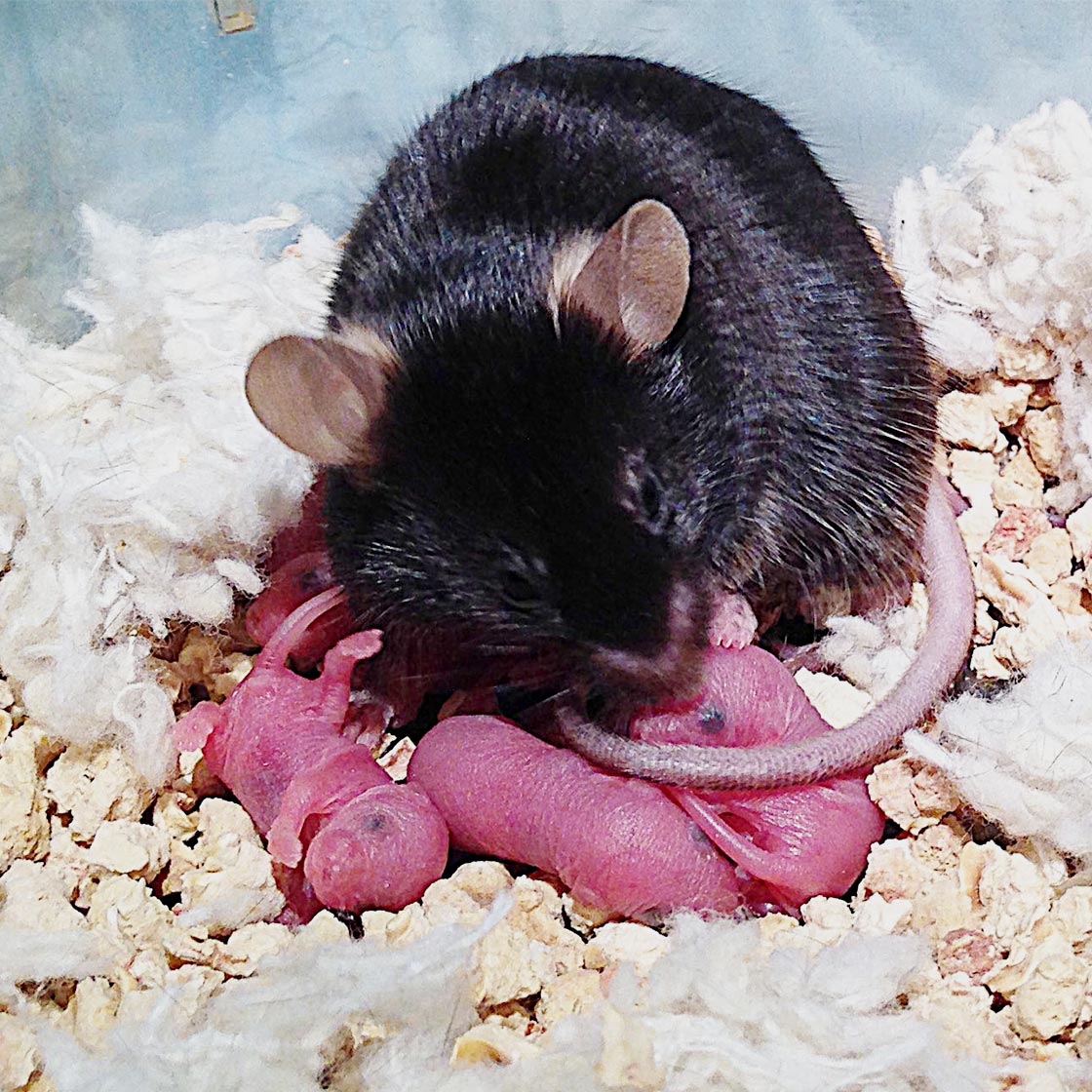Catherine Dulac Finds Brain Circuitry Behind Sex-Specific Behaviors

Catherine Dulac, a neuroscientist and developmental biologist at Harvard University, has powerfully advanced behavioral science with her studies linking the brain’s architecture to supposedly sex-specific behaviors in mammals.
Luke Zvara for Quanta Magazine
Introduction
Questions like “why do men and women act differently?” are age-old, with tangled, deeply buried answers. But that is why Catherine Dulac, a Howard Hughes Medical Investigator and a professor of molecular and cellular biology at Harvard University, has become so well respected by her neuroscientist colleagues for the originality and creativity with which she has brought important answers to light.
Though she is trained as a developmental biologist, Dulac takes her research into territory usually explored by social scientists by trying to discern the balance of genetic determination and environmental influence that shapes vital behaviors in mammals. Moreover, she deploys the genetic tools of modern biology to discover the mechanisms that activate these behaviors.
Relatively early in her career, Dulac’s investigations into how animals detect pheromones changed our understanding of what those airborne chemicals may signify to the brain. More recently, her experiments identified how the brain circuitry that regulates crucial mating and parenting behaviors works — at least in her model animals, which are mice. She found astonishing evidence that although certain of these behaviors are often described as “male” or “female,” both types of circuitry are present and potentially active in both sexes. As a result, the right combination of triggers can switch an individual creature’s behavior to that of the opposite sex.
Scientists are still exploring the full implications of her findings, but Dulac and others are hopeful that they might yield useful insights into conditions like postpartum behavioral disorders. Because of her work’s relevance, in September Dulac, just age 57, was awarded the $3 million Breakthrough Prize in Life Sciences, the richest single personal award in the scientific world. The citation for the prize hailed the success of her work, which connected behaviors to specific neural mechanisms and “overturned decades-old dogma in behavioral science.”
In three Zoom interviews from Cambridge, Massachusetts, this fall, Dulac told of the research journey that brought her to these paradigm-shifting findings. This interview is based on those conversations and has been condensed and edited for clarity.
Where did you grow up?
In Montpellier, in the south of France, where my parents were researchers in the humanities. My dad studied Denis Diderot, a philosopher of the Enlightenment who wrote the first Encyclopédie of knowledge. My mom worked on studies of the poetry of the Middle Ages.
Because my parents had the same kind of job, I never considered one of their careers as subordinate to the other. Both my parents did the domestic chores. My mom was in school during the years my brother and I were born and so, when we were young, my dad took care of us a great deal of the time. Growing up, I saw my parents as these really interesting individuals who each had their own intellectual life and career.
The fact that my two parents were kind of equal at home permitted me, a girl, to feel that the world belonged as much to me as any person.
Was this unusual in 1960s France?
I would say yes. I would visit the homes of my little friends and I quickly realized how different my family was.
For one thing, my parents really supported my interests. For instance, I was fascinated by pre-history. I probably read the novel Quest for Fire [by J.-H. Rosny] a dozen times. It really marked me. I spent a lot of time imagining prehistoric people and trying to get into their heads.


“In my research, I’ve been seeking to understand how the brain controls instinctive behaviors,” Dulac said.
Luke Zvara for Quanta Magazine
Seeing my fascination, my parents took us to look for fossils in the caves near where we lived. Once we found some bones and teeth, which turned out to be from ancient cave bears. What a thrill! We were discovering something that had been there for thousands of years and that nobody in modern times had seen before. After that, I became very interested in discovery.
The other important thing about my childhood was that our house had literally thousands of books of all kinds. There were books in all the rooms, in the corridors. I read many novels —Dostoevsky; Tolstoy; all of Proust, which I must have read five times.
I was drawn to the literature of emotions. I realized you read novels because it puts you in the shoes of others. Through their stories, you experience something else — new emotions, new encounters. These writers were asking, “What does it mean to be a human being?” I was stirred by their questions and by the idea that some understanding of emotions could be found in understanding human interactions. Why do we do what we do? Why do we need social contact?
Given your interests, why did you study biology rather than one of the social sciences?
As I mentioned earlier, I was interested in discovery. Biology was especially appealing because it had this aspect of trying to understand life. I did my Ph.D. in developmental biology in the laboratory of a very famous developmental biologist at the University of Paris.
Was that Nicole Le Douarin?
Nicole Le Douarin, yes. In her laboratory, she was asking about the respective roles of genetic preprogramming and environmental influence in embryonic development.
She was also experimenting with this very new “single cell” approach to developmental research. Instead of looking at the development of a particular tissue, she looked at a set of cells called the neural crest. They bulge out of the neural tube, the embryonic primordium of the nervous system. They migrate and give rise to the peripheral nervous system and a lot of other things like the pigment cells and the tissues that become the face.
So how do these cells decide what they will do? To understand that, Le Douarin developed this approach to look at one cell at a time and try to see what that cell would become instead of looking at all the cells together.
I still use this approach in my work today. In neuroscience, it is particularly useful because with the brain, every neuron is a bit different. You need to understand one cell at time. At the same time, you need information on enough of the different cells to understand what is generally going on. In retrospect, I’ve come to realize that two themes of Le Douarin’s work — intrinsic versus extrinsic influence and the single cell approach — are at the core of how I work.
When I was Le Douarin’s student and then later as a post-doc in Richard Axel’s lab [at Columbia University], I thought I was exploring scientific topics relating to embryonic development and sensory detection. I now think that what I was really moving toward was the use of scientific research to answer some of the questions raised by the novelists I’d read as a younger person.
Which specific questions?
Where do important behaviors come from? What is inborn? What is the result of experience? What triggers anger, sadness, dominance, aggression, mating, parenting?
In my research, I’ve been seeking to understand how the brain controls instinctive behaviors. What are the signals? What are the brain cell populations involved in triggering those behaviors, and how do they differ between animal species and between males and females?
Earlier, you mentioned the Nobel laureate Richard Axel. How did you come to work in his laboratory at Columbia?
After finishing my doctorate, I wanted to work in the United States for a few years. The neuroscience research community there was so dynamic. I wanted to experience it and then return to France. After looking at the various possibilities, I went to the Axel lab at Columbia.
I got there in 1992, a particularly exciting moment. Researchers were using molecular, genetic and cellular biology tools in new ways to understand how the brain works.
Richard Axel and Linda Buck had just made their fabulous discovery of the olfactory receptors in the rodent nose, which was the key to understanding how odorants give rise to the sense of smell. They were to receive the Nobel Prize for this.
My goal was to build on their discovery by finding the receptors for pheromones, which are the chemicals that signal for aggression, mating, parenting and other behaviors in mice and in many animals. Ultimately, I was looking for the cues that trigger instinctive behaviors in mice. The working theory I had was that the receptors for pheromones were closely related to those for olfaction.
I’ve met Professor Axel at social events. He’s an impressive figure. Did you find him intimidating?
On the contrary: He was an inspiration. He said, “In my lab, people are studying extremely difficult problems.” He wasn’t expecting you to succeed immediately. He expected you to struggle, which I certainly did. In my first two years there, I had extreme anxiety because nothing I tried worked out. Nothing!
But Richard told me, “You’re trying to resolve a very difficult problem. I think you’ll succeed. I just don’t know when.”
For me, it was a time of great self-doubt. I tried everything in the repertoire of molecular biology. I’d work till 3 in the morning. Sometimes I thought about Linda Buck, who by then had her own laboratory at Harvard. I thought, “She was in Richard’s lab for 10 years before she discovered the olfactory receptors.” But then I’d say, “Well, you’re not as smart as Linda, it will take you 15!” (Laughs.) That gave me some peace.
Why was finding the pheromone receptors so important?
Because this was a step toward understanding aspects of a larger question — not just “which behaviors are innate?” but “how is the brain involved in triggering them?”
Mice and a number of vertebrates have neurons in their noses, in something called the vomeronasal organ — the VNO. This organ detects pheromones produced by others of the same species and then sends cues to the brain to mate, attack or do other things.

The vomeronasal organ (shown here in a fluorescent stained section) enables mice and other animals to detect pheromones, but it is absent in humans. Early in her career, Dulac became the first to identify a pheromone receptor in a mammal.
To ascertain if the vomeronasal receptors were different from the smell receptors that Axel and Buck discovered, I made a library of the genes expressed by every individual neuron in the mouse VNO. I did it one cell at a time and then compared them.
This eventually led to my becoming the first to ever isolate a mammalian pheromone receptor.
Why was it such a breakthrough?
Because once we did that, it opened possibilities for discovering clues to what triggered particular mammalian behaviors. You could, for example, do experiments where you deleted a specific gene in the mouse so that it could no longer detect certain pheromones and then you’d look to see how its behavior changed. In the years to come, I did many such experiments.
I would say that until our work, there was this idea, at least for mammals, about rigid structural differences in the brain between males and females. What we found is that it is more complicated than that. It’s not as if the brains of a male and female are identical, but they are way more similar than anticipated. Yes, there are early hormonal actions that make a male brain more prone to display male-typical behavior and a female more prone to display behavior that is female-typical.
But that doesn’t mean that those brains are so different that one cannot display the behavior of the other.
Tell us about some of the experiments that brought you to this idea.
When I was a junior faculty member at Harvard, we wondered what would happen if we eliminated the cues to the brain from pheromones. Would a male mouse still be aggressive when he encountered another male, the usual behavior?
To learn this, we knocked out an essential gene in the mouse’s VNO and made him into a “pheromone-blind” mutant. We then put him together with another male mouse. The mutant did not attack the other male — he mated with him! That was a total surprise. What could be happening? Could he be mating with the male because there was no female around? So next we put both a male and female intruder into the mutant’s cage. The mutant then attempted to mate with both with equal frequency.
This suggested that the mutant’s problem was not with mating, but in distinguishing what is male from what is female.

Dulac showed that virgin male mice unable to detect pheromones will care for newborn pups, a behavior more typical of females.
The particular set of neurons in the vomeronasal organ we were looking at seemed to be dedicated to discriminating males from females. When we eliminated them and the mouse no longer could do that, though, it was still engaging in mating behavior.
We did other experiments with female mice where we removed the vomeronasal organ. Surprisingly, without the cues from pheromones, we saw females behaving like males. They would mount others and display courtship behaviors exactly like a male would. This led to the unexpected notion that circuits for typical male behaviors exist and can function in the adult female brain.
You’ve also done similar experiments on mouse parenting behaviors. Were you astonished by those results, too?
Oh yes. In most species, there are particular mechanisms in the brain for displaying behaviors that are mainly male or mainly female. In about 50 or 60 percent of mammals, the mothers are the primary infant caregivers and the males are aggressive toward the infants or neglect them.
If you take a female mouse, even if she hasn’t given birth, when you put mouse pups close to her, she will build a nest and take care of them. Now, if you put a virgin male in the same situation, he will very likely try to kill the pups.
We wondered what might happen if we removed the VNO of a virgin male mouse, removing his ability to detect pheromones. The result was extraordinary: These males were maternal. They took care of the pups. They didn’t attack them.
This made us think that the mouse brain, whether it is male or female, has circuitry that triggers parental behavior, irrespective of whether the animal is male or female. Following up on this finding, we were able to identify a specific population of neurons expressing the neuropeptide galanin that are essential and sufficient for the expression of parenting in both males and females. This discovery was the starting point for an in-depth study of the circuitry controlling distinct aspects of parental care in mice. This was, to my knowledge, the first mechanistic deconstruction of a social behavior circuit.
Does any of this have implications for humans?
Yes and no. The signals that a mouse detects are very specific to other mice. Humans and other higher primates do not have this organ for sensing pheromones. However, the areas of the brain controlling essential behaviors are thought to be conserved in evolution in all vertebrates, particularly the parts of the hypothalamus that control feeding, reproduction, mating and parenting. It is therefore very likely that the neuronal populations and associated circuitry that we discovered in mice also exist in some forms in the human brain to regulate parenting behavior.
You know, 10% to 20% of moms have postpartum depression. It’s enormous, I’ve never heard of any mental illness that affects so many people, and yet very few people talk about it. These are mothers who have real difficulty establishing emotional bonds with their infants. Maybe something doesn’t work well in the balance of their parental circuitry, in the activity of the neural population that drives parenting versus the one that drives neglect. If we can better understand that, maybe we can find drugs or diagnostic tools that can help the women suffering from this illness. And maybe the drugs can target these neurons very specifically, without the side effects of the psychoactive drugs currently in use.
Your work on the gendered brain has huge societal implications. Do you find that hard to deal with?
Yes, and that’s why I’m very cautious in what I say. When I started my lab at Harvard, I had these interesting results where a mutant mouse was mating with both males and females. The animal was affected by a particular part of a neuron that doesn’t exist in humans. So it had no relationship with human behaviors.
I was absolutely terrified that some journalist would take that result and say, “Dr. Dulac identified the gene for homosexuality” or something like that. When the paper was published in Nature, I asked them to keep the publicity very tame.
In recent years, I’ve become a little more willing to discuss some of the wider implications of my work. I am certainly willing to say that in the context of what some call “the male brain” or “the female brain,” there is more flexibility than anticipated.
What changed you?
Society changed. We know more about these issues than we did 10, 15 years ago. When it comes to sexuality and gender, people are talking more about their own struggles — in part thanks to some celebrities that brought the issue to the forefront. There’s more open discussion of sexuality generally and of matters like gender identity. So I think that now our findings in this context are way more accepted.
One event that moved me was meeting the director of the transgender clinic here at Harvard. He said that he thought our finding the circuitry of both males and females in an individual brain was extremely interesting when talking about transgender individuals. He spoke of 3- and 4-year-olds who’d tell him, “I’m not a boy” or “I’m not a girl,” suggesting that their identity had nothing to do with the environment, but was intrinsic.
It’s not clear what sets gender identity in the human brain, but the fact that in a mouse you have the physical circuitry for both male and female behaviors gives way more context for what could happen in humans. These issues are very complex, and there’s not just one model for male behavior or female behavior. Not every woman wears lipstick. Not all men are athletes. It doesn’t work that way. There’s a lot of things in between, and it does a disservice to understanding humans to say we have to obey these very narrow rules.
Do you think that over your career you’ve asked research questions that male researchers might not?
To some extent. One aspect I’ve certainly done differently was use both male and female animals in my studies.
Till very recently, the general standard was to use only male animals as models. It was said, among other things, that because of their reproductive cycle, females were too complicated to study. Yet in our studies we found way more variability among males than previously thought.
The reason for this, we don’t yet know. It might be there are dramatic differences between dominant and subordinate male mice. But the idea that there’s great variability in females and not in males is scientifically wrong.
Have you in your career run into much sexism?
I have not experienced discrimination. My mentor, Nicole Le Douarin, probably did way more than I did.
She was married and she had two children and she wanted to do research. At nearly every lab where she applied, they said, “Why do you want to do research? Your husband is a researcher. That should be sufficient.”

Dulac does not feel that she has experienced much discrimination in her career, but she has seen how even cloaked sexism can oppress women in science.
Luke Zvara for Quanta Magazine
For myself, I have always felt respected by my colleagues. But I have sometimes noticed things that happen in one’s professional life.
If, for instance, I go to a conference and it’s the first evening of the meeting, if my neighbor at the dinner table is a man and he hasn’t seen my name on the place card, very often, I have the feeling that he’s not interested in anything I have to say.
Then, it turns out that I am the one giving the keynote lecture, and that same guy now comes to me and says, “Oh, my God. This is so interesting.” Like, surprise, surprise, right? This has happened many times. It’s comical.
One of your former post-docs, Anita Autry, now of the Albert Einstein College of Medicine, tells me that when you submit grant proposals or papers, the anonymous reviewers sometimes write comments reeking of sexism. She theorizes that they are able to hide behind the anonymity to dress down a successful woman. Is she right?
It is interesting that you’re bringing this up. It is actually a problem for editors and it’s a problem for the National Institutes of Health. When women make submissions, they get slammed for perceived weaknesses, while the men are more frequently given the benefit of the doubt. The critiques are often insulting, condescending.
I remember applying for a collaborative grant with two women colleagues who are extraordinary scientists themselves, Aviv Regev at the Broad Institute and Xiaowei Zhuang at Harvard. And here you have three really well-known women applying. I thought our grant was, frankly, spectacular, but when we got the reviews, we received top scores but some of the comments were just nasty. And I remember having a sense that even the program officer at the NIH was embarrassed by them. There was such a discrepancy between the quality of the grant proposal and the nastiness of the comments. Similarly, when we submit manuscripts, unacceptable things happen. I’m pretty sure that some of my male colleagues also get nasty reviews. But statistically speaking, getting nasty and condescending language is more frequent for women.
Recently, I submitted a paper involving hardcore electrophysiology, which is not my specialty. I had a male electrophysiologist collaborate on it. When the comments came back, one reviewer basically said I had no idea what I was doing. But again, the particular work that involved electrophysiology was actually done and written up by my collaborator, a very experienced electrophysiologist. He told me he never, ever had comments like this, ever in his life.
Early in this interview, you said that after you’d finished your post-doc in the Axel lab, you intended to return to France. What happened?
You are right. I intended to return. After all, I am French and there is much in the French culture and way of life that is wonderful. In their private lives, French people enjoy themselves more than here.
But academic traditionalism is a real thing. After finishing my post-doc, I went back to France to find a job, and there was such a discrepancy between what I was offered there and what I might be offered in the U.S. I was told I was way too young to have my own laboratory, that I still had to learn from a more senior person.
More than anything, I wanted to have my own laboratory and to have fun doing more research. I ended up at Harvard where these things could happen. (Laughs.) Then they “trapped” me because Harvard gave me tenure quickly — in roughly five years.
Long ago in another century, Sigmund Freud declared “biology is destiny.” In your lab, are you disproving that?
Well, it is [destiny]. But at the same time, biology is also flexible. And I like that.




